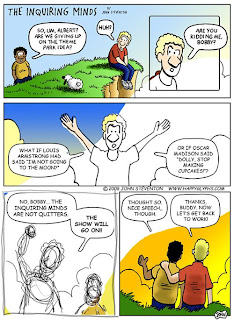
Since I'm already in a mood, I'm going to say something that I've been holding back on. Every once in a while, I get emails from people which basically say, "I've got a great idea for a comic strip. How do I go about creating it so I can be rich and famous?". I honestly don't think I've even replied to one of those emails because a) the person writing wants free advice without a "how do you do?", usually thinks the answer can be summed up in an email, and c) has done absolutely no homework whatsoever.
Now, if you have a specific question, I'm usually happy to answer it. However, I've been burned a few times by people who have 'befriended' me, and then disappeared after I divulged hard earned secrets, so I can still be shy.
What really bothers me is this... today's generation horrifies me in it's lack of ability. When I wanted to be a Cartoonist, I didn't write a Cartoonist, I... sit down for this... went to the library!! Yes, believe it or not, but libraries are not a place to dump your latchkey kids after school, are not places to 'hook up', and certainly not places to sit and chat on your cell phone. They are places, like schools, where you can actually learn things.
When I knew that what I wanted to be was a Cartoonist, I spent about a month in the library, photocopying great comic strips, reading about Cartoonists in their biographies, memorizing books like the Artist's & Graphic Designers Market, and basically learning all that I could... before even sitting down with a pencil and paper to draw! I also cut comic strips out of the newspaper, measured them, and tried to figure out the original drawing size that my favorite artist's drew at. i also started buying comic strip collections of my favorite comic strips.
In short, I wanted it so bad that I invested a lot of time in learning the craft, before even starting. On top of this, I had already taken drafting classes, which I recommend highly, and some art classes. As I became a Cartoonist, I realised just how much I had to learn, like Life Drawing, writing, anatomy, biology, painting, 2-d design, typography... the list goes on. I went to art museums, took classes at the local college, and was lucky enough to be close enough to the Joe Kubert School of Cartooning to be able to take night classes there.
In short, I learned Cartooning the classic, traditional way, and again, I recommend this highly. There are some tht do everything on the computer these days, but I'm willing to bet that most of them learned the old fashioned way.
This consists of thumbnail sketches, rough sketches, tighter pencils, inking on paper with a pen or brush or both, then correcting with whiteout or a razor blade, a neat trick I learned in reading George Herriman's biography. If you draw on two ply Bristol or art board, you can actually cut mistakes off of the paper with a sharp razor and steady hand, which copies better than whiteout or erasing.
Knowing what you are doing by hand helps to do things on the computer better. Computers are a great tool for a cartoonist who knows what he or she is doing. On a computer, you can lay out your panels, do the lettering, make the word balloons, and even draw easier, neater, and often faster. This seems real neato, but look at the result: dullsville. Not always, but there's something about the slight flaws you find in hand drawn art that appeals to the eye. Some Cartoonist's say you're not a real Cartoonist unless you draw with a sable brush, because pen lines don't have the variety of line that makes a good cartoon look so nice.
I'm also a firm believer in doing your own lettering. Your lettering is like your art... very personal, and your lettering looks best next to your art. Other lettering, and computer lettering, again could look wrong, or dull.
Now,do I follow my own advice? No, of course not. :0)
Actually, I try to. I got really out of practice for a while, and my lettering was getting atrocious, and worse, illegible, so sometimes I use Comic Sans, which closely resembles how I learned to letter, so it doesn't look too bad.
I am attaching a Sunday cartoon autopsy, to give you who are really interested an idea of how I work. You can see hand lettering and computer lettering, a thumbnail sketch, and a tight pencil sketch, and the inked art before and after coloring.
By all means, write if you want to learn more. I won't bite, but I also won't answer unless I think you are serious. Do some homwework first, huh? Show some commitment, will ya? And buy original art, whether from me or someone else, because you can learn alot from studying the original drawings and comparing them with the final print versions.
All of this is only scratching the surface of course. Writing a strip, as I've mentioned in other blogs, is a whole other boatload of fish to fry.
Whew. I'm exhausted. Hope you learned something. JOHN :0)








2 comments:
Now me...I learned cartooning the easy way. I nicked all my ideas from other cartoonists and then threw in a few swearwords to make 'em appeal to a young audience.
Well, that's ONE way to do it, I suppose. :0)
"There are many paths, Grasshopper, to one destination", as the sages say.
Of course, if the sage is talkin, there's probably some mighty suspicious herbs in your garden. :0)
The image has finally uploaded, by the way. Cheers, JOHN :0)
Post a Comment